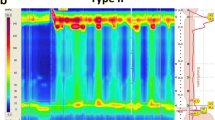Abstract
Many studies have been conducted analyzing the manometric properties of patients with achalasia, but the striated portion of the esophagus has never been analyzed and is often overlooked. We retrospectively reviewed 120 manometric tracings (20 achalasia, 100 controls) performed between 1994 and 1997 and excluded tracings from patients with chronic cough and nutcracker esophagus. The data were assessed for age, sex, symptoms, duration of symptoms, lower esophageal sphincter pressure, gastroesophageal gradient, upper esophageal sphincter pressure, smooth muscle contraction amplitude and duration, striated muscle contraction amplitude and duration, length from upper esophageal sphincter to maximal striated muscle contraction, and esophageal length. The maximum striated muscle contraction amplitude was significantly decreased in achalasia patients with a median amplitude of 45 mm Hg (range 12–95) vs 76 mm Hg (range 30–210) in the control group (P = 0.002). Although the wave forms were similar, the maximum striated muscle contraction duration and the distance from the upper esophageal sphincter in achalasia patients was not significantly different from controls. The length of the esophagus was significantly longer in achalasia patients with a median value of 25 cm (range 21–30) vs 21 cm (range 17–26) in the control group (P < 0.001). Patients with achalasia have significantly lower maximum striated muscle contraction amplitudes and longer esophagi, but the duration of the contractions and the configuration of the wave forms are not different.
Similar content being viewed by others
REFERENCES
Koshy SS, Nostrant TT: Pathophysiology and endoscopic/balloon treatment of esophageal motility disorders. Surg Clin North Am 77(5):971-979, 1997
Couturier D, Samama J: Clinical aspects and manometric criteria in achalasia. Hepatogastroenterology 38(6):481-487, 1991
Affolter H: The clinical application of intraluminal esophageal manometry. Digestion 2(4):242-244, 1969
Vela AR, Balart LA: The clinical value of esophageal intraluminal manometry. Am Surg 34(1):39-47, 1968
Manier JW, Mulholland DD: Esophageal manometry in clinical medicine. Am J Gastroenterol 54(2):101-111, 1970
Cassella RR, Ellis FH Jr, Brown AL: Fine-structure changes in achalasia of the esophagus: II. Esophageal smooth muscle. Am J Pathol 46:467, 1965
Harman JW, O'Hegarty MT, Byrnes CK. The ultrastructure of human smooth muscle: I. Studies of cell surface and connections in normal and achalasia esophageal smooth muscle. Exp Mol Pathol 1:204, 1962
Roman C, Gonella J: Extrinsic control of digestive tract motility. In Physiology of the Gastrointestinal Tract, 2nd ed. LR Johnson (ed). New York, Raven Press, 1987
Longstreth GF, Walker FD: Megaesophagus and hereditary nervous system degeneration. J Clin Gastroenterol 19(2):125-127, 1994
Birgisson S, Richter JE: Achalasia: What's New in Diagnosis and Treatment? Dig Sci 15(suppl 1):1-27, 1997
Kahrilas RJ: Functional Anatomy and Physiology of the Esophagus. In The Esophagus, 2nd ed. DO Castell (ed). Boston, Little, Brown, 1995
Li Q, Castell DO: Manometric determination of esophageal length. Am J Gastroenterol 89(5):722-725, 1994
Author information
Authors and Affiliations
Rights and permissions
About this article
Cite this article
Dunaway, P.M., Maydonovitch, C.L. & Wong, R.K. Characterization of Esophageal Striated Muscle in Patients with Achalasia. Dig Dis Sci 45, 285–288 (2000). https://doi.org/10.1023/A:1005400323789
Issue Date:
DOI: https://doi.org/10.1023/A:1005400323789




